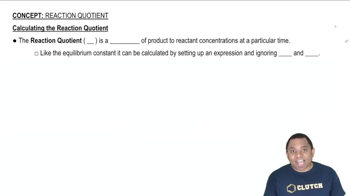Consider the reaction: NH4HS(s) ⇌ NH3(g) + H2S(g) At a certain temperature, Kc = 8.5⨉10-3. A reaction mixture at this temperature containing solid NH4HS has [NH3] = 0.166 M and [H2S] = 0.166 M. Will more of the solid form or will some of the existing solid decompose as equilibrium is reached?
Ch.15 - Chemical Equilibrium

Chapter 15, Problem 48
Consider the reaction: 2H2S(g) ⇌ 2H2(g) + S2(g). Kp = 2.4 * 10^-4 at 1073K. A reaction mixture contains 0.112 atm of H2, 0.055 atm of S2, and 0.445 atm of H2S. Is the reaction mixture at equilibrium? If not, in what direction will the reaction proceed?
 Verified step by step guidance
Verified step by step guidance1
Calculate the reaction quotient, Qp, using the expression for the equilibrium constant Kp: \( Q_p = \frac{(P_{H_2})^2 \cdot (P_{S_2})}{(P_{H_2S})^2} \).
Substitute the given partial pressures into the expression: \( Q_p = \frac{(0.112)^2 \cdot (0.055)}{(0.445)^2} \).
Compare the calculated Qp with the given Kp (2.4 \times 10^{-4}).
If \( Q_p = K_p \), the system is at equilibrium. If \( Q_p < K_p \), the reaction will proceed in the forward direction to reach equilibrium. If \( Q_p > K_p \), the reaction will proceed in the reverse direction to reach equilibrium.
Determine the direction of the reaction based on the comparison of Qp and Kp.
Key Concepts
Here are the essential concepts you must grasp in order to answer the question correctly.
Equilibrium Constant (Kp)
The equilibrium constant (Kp) is a numerical value that expresses the ratio of the concentrations of products to reactants at equilibrium for a given reaction at a specific temperature. For the reaction 2H2S(g) ⇌ 2H2(g) + S2(g), Kp is calculated using the partial pressures of the gases involved. A Kp value less than 1 indicates that at equilibrium, the reactants are favored over the products.
Recommended video:
Guided course

Equilibrium Constant Expressions
Reaction Quotient (Qp)
The reaction quotient (Qp) is calculated using the same formula as Kp but uses the current concentrations or partial pressures of the reactants and products in the system. By comparing Qp to Kp, one can determine whether the reaction is at equilibrium (Qp = Kp), or if it will shift towards the products (Qp < Kp) or reactants (Qp > Kp) to reach equilibrium.
Recommended video:
Guided course

Reaction Quotient Q
Le Chatelier's Principle
Le Chatelier's Principle states that if a dynamic equilibrium is disturbed by changing the conditions, the system will adjust itself to counteract the change and restore a new equilibrium. This principle helps predict the direction in which a reaction will shift when the concentrations of reactants or products are altered, or when temperature or pressure changes occur.
Recommended video:
Guided course

Le Chatelier's Principle
Related Practice
Textbook Question
Textbook Question
Silver sulfate dissolves in water according to the reaction: Ag2SO4(s) ⇌ 2 Ag+(aq) + SO42-(aq) Kc = 1.1⨉10-5 at 298 K. A 1.5-L solution contains 6.55 g of dissolved silver sulfate. If additional solid silver sulfate is added to the solution, will it dissolve?
Textbook Question
Consider the reaction and the associated equilibrium constant: aA(g) ⇌ bB(g) Kc = 4.0 Find the equilibrium concentrations of A and B for each value of a and b. Assume that the initial concentration of A in each case is 1.0 M and that no B is present at the beginning of the reaction. c. a=1;b=2
2
views
